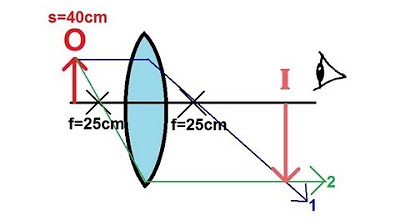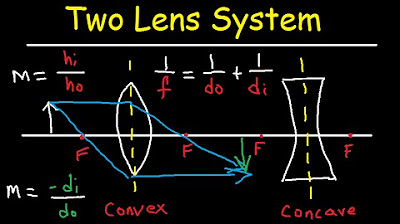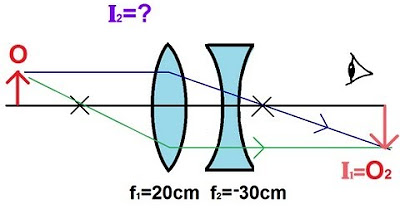Physics - Optics: Lenses (1 of 2) Diverging Lens
TLDRThis video explores the concept of a diverging lens, a unique optical element that causes parallel light rays to spread out as if emanating from a focal point in front of the lens. The presenter demonstrates how to determine the position and characteristics of the virtual image formed by a diverging lens using geometric techniques and equations. They calculate the image location and magnification for an object placed beyond the lens's focal point, revealing a smaller, upright virtual image. The script also hints at further exploration with objects placed inside the focal point in a subsequent video.
Takeaways
- 🌟 The video discusses a new type of lens called the diverging lens, which is unique in its properties compared to other lenses.
- 🔍 When light rays parallel to the normal pass through a diverging lens, they diverge as if emanating from a focal point in front of the lens.
- 📐 The name 'diverging lens' comes from the way it causes light rays to spread outward from the focal point, unlike converging lenses that bring rays together.
- 👀 For the first example, an object is placed beyond the focal point of the lens, and the video explains how to determine the location of the image formed.
- 📏 The technique involves drawing rays from the object, one parallel to the normal and the other through the focal point, to predict where the image will form.
- ✏️ The video uses a blue pen to illustrate the path of the rays and how they diverge after passing through the lens.
- 🧠 The human brain interprets the diverging rays as if they were coming from a single point, creating a virtual image on the opposite side of the lens.
- 🔢 The exact location of the image is calculated using the lens equation \( S' = \frac{S \times F}{S - F} \), where \( S \) is the object distance, \( F \) is the focal length, and \( S' \) is the image distance.
- 📉 In the example, with an object at 50 cm and a focal length of -25 cm, the calculation shows the image forms at -16.7 cm, indicating a virtual image in front of the lens.
- 🔄 The magnification of the image is determined to be 1/3 of the object's size, and since it's positive, the image is upright and has the same orientation as the object.
- 🔄 The video also hints at trying another example with the object placed inside the focal point to explore how it affects the image formation with a diverging lens.
Q & A
What is a diverging lens?
-A diverging lens is a type of lens that causes light rays to spread out or diverge. Unlike converging lenses, which bring light rays together, diverging lenses cause the rays to appear as if they are coming from a focal point in front of the lens.
How do light rays behave when they pass through a diverging lens?
-When light rays parallel to the normal enter a diverging lens, they diverge as if they originated from a focal point in front of the lens. This causes the rays to spread out rather than converging at a point.
What is the significance of the focal point in the context of a diverging lens?
-For a diverging lens, the focal point is significant because it is the point from which the diverging rays appear to originate. Since the lens is diverging, the focal length is negative, and the focal point is located in front of the lens.
How does the position of an object relative to the focal point of a diverging lens affect the image formation?
-The position of the object relative to the focal point of a diverging lens determines where the image will appear and its characteristics. If the object is beyond the focal point, the image will be formed on the same side of the lens as the object, but it will be virtual and smaller in size.
What is the equation used to determine the image distance (S') in the context of a diverging lens?
-The equation used to determine the image distance (S') for a lens is S' = S * F / (S - F), where S is the distance to the object, and F is the focal length. For a diverging lens, the focal length (F) is negative.
What does a negative focal length indicate for a lens?
-A negative focal length indicates that the lens is a diverging lens. This means that it causes light rays to spread out rather than converging at a point, which is characteristic of a converging lens.
How can you determine the exact location of the image formed by a diverging lens?
-You can determine the exact location of the image by using the lens equation S' = S * F / (S - F) and plugging in the known values for the object distance (S) and the focal length (F) of the lens.
What is the difference between a real image and a virtual image in the context of lens optics?
-A real image is formed where light rays actually converge and can be projected onto a screen, whereas a virtual image is formed where the light rays appear to diverge from. A virtual image cannot be projected onto a screen but can be seen by looking into the lens.
What does the magnification (m) of an image indicate?
-The magnification (m) of an image indicates how much larger or smaller the image is compared to the object. It is calculated as the ratio of the image distance (S') to the object distance (S). A positive magnification means the image is upright, while a negative magnification would mean the image is inverted.
How does the orientation of the image relate to the magnification value in the context of a diverging lens?
-If the magnification value is positive, it indicates that the image is upright and in the same orientation as the object. If it were negative, the image would be inverted, which is not the case with a diverging lens as described in the script.
What happens when an object is placed inside the focal point of a diverging lens?
-When an object is placed inside the focal point of a diverging lens, the image will still be virtual and appear on the same side of the lens as the object. However, the exact location and size of the image will differ from when the object is placed beyond the focal point.
Outlines
🔎 Introduction to Diverging Lenses
This paragraph introduces the concept of a diverging lens, a type of lens that causes light rays to spread apart. It explains that unlike converging lenses, diverging lenses have a negative focal length and that rays parallel to the normal appear to come from a focal point in front of the lens. The explanation includes a step-by-step guide on how to trace rays through a lens to determine the location of the virtual image formed by the lens. The presenter uses a blue pen to illustrate the process and mentions the use of specific techniques and equations to calculate the image location.
📏 Calculating Image Location with Diverging Lens
The second paragraph delves into the practical application of the principles discussed in the first paragraph. It describes a scenario where an object is placed beyond the focal point of a diverging lens and uses the lens formula \( S' = \frac{S \times F}{S - F} \) to calculate the exact location of the image formed. The presenter provides numerical values, with the object distance (S) being 50 cm and the focal length (F) being -25 cm, leading to a calculation that results in an image distance (S') of -16.7 cm, indicating a virtual image located 16.7 cm in front of the lens. The paragraph also explains the concept of magnification (m), calculating it to be 1/3, which means the image is one-third the size of the object and is upright.
Mindmap
Keywords
💡Diverging Lens
💡Focal Point
💡Normal
💡Ray Tracing
💡Virtual Image
💡Focal Length
💡Magnification
💡Upright Image
💡Lens Equation
💡Negative Sign
Highlights
Introduction to the concept of a diverging lens, which is a unique type of lens that causes light rays to diverge as if they originated from a focal point in front of the lens.
Explanation of how a diverging lens works with parallel light rays in relation to the normal, resulting in the rays appearing to come from a virtual focal point.
Demonstration of the path a ray of light takes through a diverging lens, using a drawing to illustrate the concept.
Description of the process to determine the location of the image formed by a diverging lens when an object is placed beyond the lens's focal point.
Use of specific techniques with a blue pen to illustrate the path of light rays and the formation of the image.
Detailed explanation of the first ray's behavior when it diverges from the lens as if coming from the focal point in front of the lens.
Clarification on the negative focal length of a diverging lens and its implications on the location of the focal point.
The observer's perception of the diverging rays and the brain's interpretation to form a virtual image.
Calculation of the exact location of the image using the lens equation and substitution of given values.
Result of the calculation indicating the image distance and its negative value signifying a virtual image.
Explanation of the virtual image's position in front of the lens and its relation to the focal point.
Introduction to the concept of magnification and its calculation for a diverging lens.
Determination of the image's size as one-third of the object's size and its upright orientation.
Conclusion on how the image is formed with a diverging lens and its characteristics.
Announcement of a follow-up example involving an object placed inside the focal point of a diverging lens in the next video.
Transcripts
Browse More Related Video

Physics - Optics: Lenses (2 of 2) Diverging Lens

Physics - Optics: Lenses (3 of 4) Converging Lens

GCSE Physics - How to Draw Ray Diagrams #70

Multiple Two Lens System with Diverging and Converging Lens

Physics - Optics: Lenses (3 of 5) Lens Combinations - Converging & Diverging Lenses

Physics - Optics: Lenses (1 of 4) Converging Lens
5.0 / 5 (0 votes)
Thanks for rating: